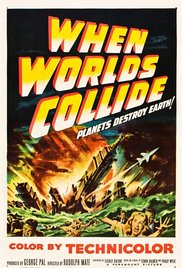Previous FilmWestworld
Next FilmWhite Space
When Worlds Collide 1951
 | As a new star and planet hurtle toward a doomed Earth, a small group of survivalists frantically work to complete the rocket which will take them to their new home. |
The Cast
| Richard Derr | - | David Randall |
| Barbara Rush | - | Joyce Hendron |
| Peter Hansen | - | Dr. Tony Drake |
| John Hoyt | - | Sydney Stanton |
| Larry Keating | - | Dr. Cole Hendron |
| Rachel Ames | - | Julie Cummings |
| Stephen Chase | - | Dr. George Frye |
| Frank Cady | - | Harold Ferris |
Film Trivia
George Pal wanted to film the novel's sequel, "After Worlds Collide," which depicted the struggle of human survivors on the alien planet. However, the failure of his film Conquest of Space (1955) badly damaged his career and the sequel was never made.
There is a shot toward the end of a group of people sitting around a country store listening to the radio. Among them the little boy and dog later rescued by helicopter. The same shot shows up in The War of the Worlds (1953)
The rocket was designed by space artist Chesley Bonestell.
The rights to the story by Philip Wylie and Edwin Balmer were originally bought in 1933 by Paramount, when director Cecil B. DeMille was planning a related project called "The End of the World." DeMille had hoped to rush the project into production after filming wrapped on This Day and Age (1933), but the script was never even written and the studio scrapped the project.
When the effects of Zyra are shown there is a shot of a volcano erupting where the side of the peak falls outward. This same shot was used in other George Pal films, including The Time Machine (1960) and Atlantis: The Lost Continent (1961).
In the mid -70's, David Zanuck and David Brown worked on a remake for which Anthony Burgess wrote the screenplay. It never got off the ground.
George Pal originally envisioned this as a big budget sci-fi movie. However, he found he was unable to secure the proper financing so he had to scale his ambition back considerably for the finished film.
Film debut of Stuart Whitman.
Douglas Fairbanks Jr. was originally considered for the part later taken by Richard Derr.
Film debut of Rachel Ames (as Judith Ames).
Supposedly there is a remake in the works with Steven Spielberg attached as director and producer.
Film debut (uncredited) of Mary Murphy.
Screenwriter Bruce Joel Rubin saw this film when he was 10-years-old. He has cited it as "the beginning of the emergence of philosophy in my life." In The Dialogue: An Interview with Screenwriter Bruce Joel Rubin (2007), he explains that right after he and a boyhood saw the film, they spent four hours talking about "the end of days." Rubin mentions this memory while explaining that Steven Spielberg approached him to do the screenplay for a remake of "When Worlds Collide," and that this project eventually became Deep Impact (1998), with Rubin credited as one of its two writers.
Roy Thinnes makes an appearance after the first planet passes. He comes in and asks "is there anymore for the helicopter"
A project of producers Richard D. Zanuck and David Brown to do a remake of the film, with Steven Spielberg as another producer and as director, evolved into the film, Deep Impact (1998), about attempts to stop a comet that was on a collision course with Earth. Zanuck and Brown were producers and Spielberg was an executive producer of that latter film.
In the final shot we see the Ark passengers disembarking with an obvious painted background depicting Zyra. This bad painting was tacked on for the film's sneak previews. Originally, producer George Pal wanted to depict Zyra as a miniature set, but Paramount shipped the film out before this could be done.
In the matte painting at the end, an immense artificial structure of some sort can be seen on the left, yet no one appears to notice it.
Just after the take off a fuel check is made. The fuel gauge is the same as a 1950s car, 1/4, 1/2, full etc. A plane or Space Ship would have fuel measured in pounds, if fuel was such a critical issue.